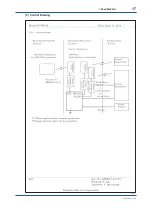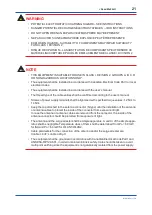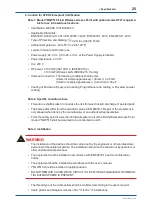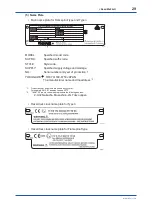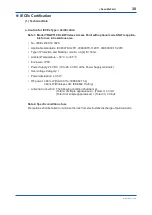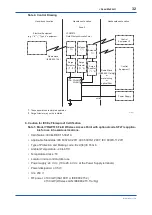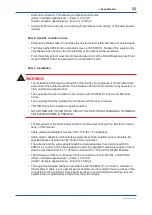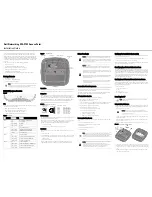
21
<Read Me First>
IM 01W02E01-11EN
WARNING
• POTENTIAL ELECTROSTATIC CHARGING HAZARD – SEE INSTRUCTIONS
• DANGER POTENTIEL DE CHARGES ÉLECTROSTATIQUES – VOIR INSTRUCTIONS
• DO NOT OPEN WHEN AN EXPLOSIVE ATMOSPHERE MAY BE PRESENT
• NE PAS OUVRIR SI UNE ATMOSPHÈRE EXPLOSIVE PEUT ÊTRE PRÉSENTE
• EXPLOSION HAZARD – SUITABILITY OF COMPONENTS MAY IMPAIR SUITABILITY
FOR CLASS I, DIVISION 2
• RISQUE D’EXPLOSION – LA SUBSTITUTION DE COMPOSANTS PEUT RENDRE CE
MATÉRIEL INACCEPTABLE POUR LES EMPLACEMENTS DE CLASSE I, DIVISION 2
NOTE
• THIS EQUIPMENT IS SUITABLE FOR USE IN CLASS I, DIVISION 2, GROUPS A, B, C, D
OR NON-HAZARDOUS LOCATIONS ONLY.
• The equipment shall be installed in accordance with Canadian Electrical Code Part I or local
electrical codes.
• The equipment shall be installed in accordance with the user’s manual.
• The thread type of the cable entries shall be confirmed according to the user’s manual.
• Screws of power supply terminals shall be tightened with specified torque values: 1.2 Nm to
1.4 Nm.
• Keep the cap attached to the antenna connector (N type) until the installation of the antenna
or antenna cables to protect the inside of the connector from exposure of light.
In case the antenna or antenna cables are removed from the connector, the inside of the
antenna connector should be protected from exposure of light.
• The antenna and the surge arrester shall be simple apparatus. Li and Ci of the simple appa
-
ratus shall be negligible. Temperature class of them shall be determined from Po = 60 mW
for ISA and Po = 64 mW for WLAN1/WLAN2.
• Cable parameters for the connection of the antenna and/or the surge arrester are:
Ccable ≤ 4 nF; Lcable ≤ 20 μH
• The equipment shall be grounded in accordance with Canadian Electrical Code Part I and
ANSI/ISA-RP12.06.01, in order to maintain intrinsic safety. Care should be taken to avoid
multi-point earthing since the equipment is not galvanically isolated from the power supply.











